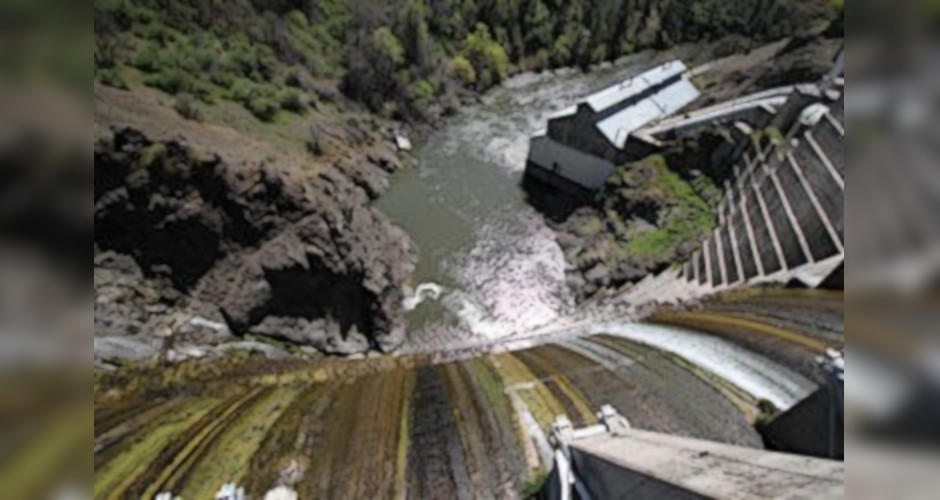— Published with Permission of HeraldandNews.com —
Although the contract has yet to be awarded and the operating license hand-over has yet to be approved, Kiewit Infrastructure West is seeking to give local contractors as much detail as it can regarding the proposed removal of four hydroelectric dams on the Klamath River.
Representatives from Kiewit met with about 30 local contractors Tuesday night at the Cerulean Hotel in Downtown Klamath Falls. It’s one of several stops the international construction firm is making in anticipation of winning the lead contractor bid.
“This could mean a lot of jobs and full hotels in Klamath for quite a while,” said Mark Anderton of Klamath Falls, who does earth moving for a living. “I’d like to have a job that is close to home.”
Michael Farrauto, of Epoch Geospatial and land surveying services of Ashland, also hoped to win a bid with Kiewit. “There should be quite a bit of surveying work for roads, bridges, culverts,” he said. “I travel all over the country but it would be nice to find work closer to home.”
Kiewit is one of three major construction operators vying as the lead designer on the project, believed to be one of the largest dam removal projects in the U.S. The other two are: Barnard Construction Co. based in Bozeman, Mont., and Granite Construction Co. based in Watsonville, Calif.
The project is to remove the J.C. Boyle in Oregon, Copco 1 and 2 and Iron Gate in Northern California along the Klamath River starting in 2021. The dams belong to the PacifiCorp utility, which is seeking permission from the Federal Energy Regulatory Commission (FERC) to transfer the license to the Klamath River Renewal Corp. KRRC anticipates selecting a winning construction firm in March 2019.
Phil Dupuis, business manager for Kiewit, told the gathering, “It’s very important to us that you have the opportunity to compete for these projects. And it’s important that contractors stay in touch with us.” (See sidebar)
The bidding process is slightly different than the norm, given the enormity of the project. It is what is known as a Progressive Design Build. In general, the lead contractor assembles a team of experts regarding the various parts of the project. From there, the team selects the subcontractors as needed and when they are needed.
“So, the contractors may not be bidding on the project until a year or two down the road,” Dupuis said. It also helps align the costs so they are fair to all the parties involved.
“We work as a team with KRRC to finalize the design, optimize the construction plan,” Dupuis said. “It’s a really good way to deliver a complex project with this since there may be a lot of unknowns. It removes some of the risk and uncertainties to both sides.”
The pricing component only takes one up to the 60 percent of the design phase. Once completed, everything after that is a negotiation between the successful bidder and KRRC.
The team members that Kiewit are employing include: Knight Piesold, an international firm, as the prime design partner; with design and permitting support by specialty teams from Northwest Hydraulic Consultants based in Sacramento, Calif.; and ICF Consultants a global technology and marketing firm.
Removal of the four dams is believed to be the biggest such project in the West, tentatively scheduled to start in 2021, with a cost approaching $400 million.
The goal is to create a natural flow in the lower river so that spore bacteria harmful to Coho and Chinook salmon will be flushed downstream. Now, with the slow-moving water, the bacteria have a comfortable environment to thrive, putting the salmon at risk. If it works, more water could become available for irrigators.
On the economic horizon is that creation of some 400 to 500 jobs needed for the deconstruction of the dams, plus up to 1,500 indirect jobs that would support that work.
Our team consists of Kiewit as the prime contractor, Knight Piesold as the prime design partner, with design and permitting support by specialty teams from Northwest Hydraulic Consultants and ICF Consultants.
FERC is still in the process of reviewing KRRC’s plan, but according to David Meurer, community liaison for KRRC, the group hopes to receive a decision on the transfer application in 2019.
“Then FERC will move on to the surrender application. We are also in the process of obtaining other major regulatory approvals, including a 401 Water Quality permit from the California State Water Resources Control Board, a 404 Water Quality permit from the Army Corps of Engineers, and a Biological Opinion from the Fish and Wildlife Service and National Oceanic Atmospheric Administration.”


